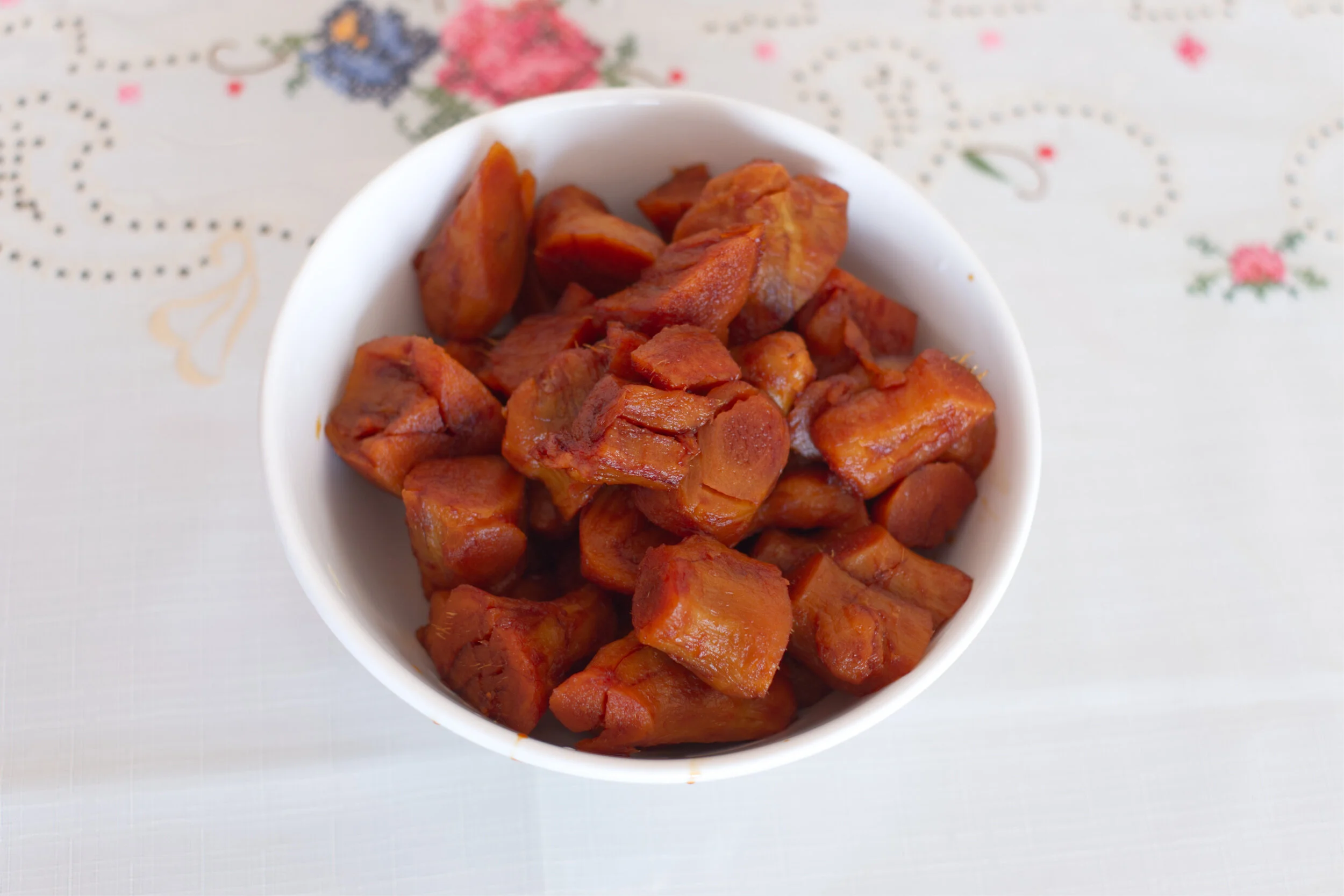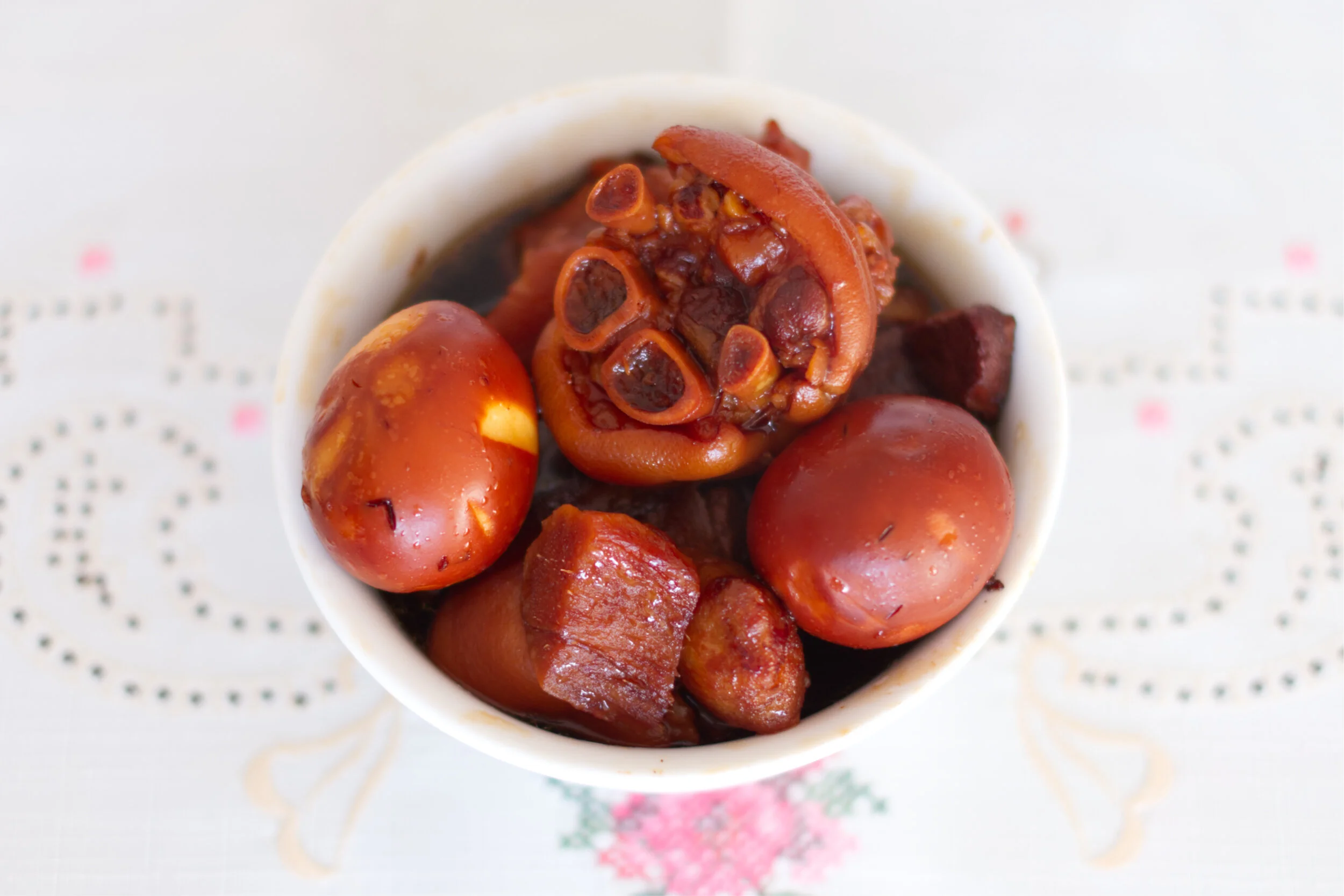Sweet and Sour Pig Trotters and Ginger - 糖醋豬腳薑 - Tong Chou Jyu Geuk Geung

糖醋豬腳薑 tong chou jyu geuk geung or sweet and sour pig trotters and ginger is a traditional Cantonese dish. It’s most commonly found in 中山 Zhongshan where my family is from. According to my family, it’s also very popular in the Guangdong capital of Guangzhou and Hong Kong. 中山 Zhongshan grows a lot of ginger because of the terroir and it’s produces especially high quality ginger there. It shouldn’t be a surprise that traditional dishes tend to reflect what the land produces. My mom says that there are a lot of specialty restaurants in 中山 Zhongshan that only make this dish and it can be quite expensive because these specialty stores will get the highest quality ingredients available and make it with extra care.
While this dish is generally enjoyed and can evoke a nostalgic feeling for many, this is also a dish that was traditionally eaten by women after childbirth in 中山 nutritious. My mom explained to me that there are some principles in Chinese medicine that also influenced why this dish was eaten right after childbirth. The pig trotters, ginger, and eggs are all nutritious and helpful in regaining general health and strength after childbirth. Consuming the vinegar also has the effect of helping clearing away any blood clots to help regulate blood circulation as part of the woman’s recovery.
After birth when the body is weakened, it’s more susceptible to the effects of 寒風 hon fung or cold northern winds that can make the body feel cold, dizzy, or have chilliness in the upper body or cold fingers/toes. The belief is that simply by breathing in the cold air at times can offset the body’s balance and these effects can be exacerbated if your body is already weakened. Ginger has an effect of warming the body by 驅風 keui fung or expelling the cold air from your body and to help warm it up.
Whether or not you believe in this, it’s still a delicious dish. My mom says that it pairs really well with white rice as well and that this is also very comforting as cold weather food. One of the things about this dish is that it doesn’t need to be refrigerated as well. The ingredients are all cooked with ingredients for pickling as well. I’d recommend trying to make it once in a while.
The beginning of the recipe follows the same steps as making pickled ginger.
RECIPE:
Aprox 2 lbs old ginger
2 pig trotters, pre-cut by butcher
1 bottle of 添丁甜醋 sweetened black vinegar (Koon Chun brand)
冰糖 bing tong or rock sugar
Water
Distilled or apple cider vinegar, about 1/4 cup
Salt, to taste
片糖 pin tong or brown sugar the Chinese kind that are sold in bricks
Eggs, about 6
The majority of ginger available in America is old ginger. If you can get your hands on the young ones where you can still see the shoots, the skin is smooth, and there’s even a slight pink color to it, then this is it. You can just boil and simmer it once and it should be tender all the way through and ready for the next step. If you have young ginger, then the dish can be ready in a day, but chances are in America since you will have only access to old ginger then the recipe will take at least 3 days for it to be ready.
Peel ginger with a spoon. With a cleaver, slice into pieces about 1-2 inches thick slightly smash the side of the ginger so it can readily absorb flavor. The pieces should retain its shape. Set aside.
In a pot, add the ginger pieces and add the bottle of 添丁甜醋 sweetened black vinegar and 冰糖 bing tong (rock sugar) to taste. Add 1 cup of water, and about 1/4 cup of the distilled or apple cider vinegar. Bring this to a boil over high heat. Once the vinegar boils, drop the heat to low, cover and simmer for about 10 - 15 minutes. Taste and adjust the seasoning to your preference.
For old ginger, you will need to bring to a boil over high heat, drop the heat to low, cover and simmer for about 10 - 15 minutes at least once a day, preferably 2 times or more per day over 3 days or until the old ginger is soft and tender. Preferably, this should boiled and simmered once in the morning and once at night. The pot and its contents do not need to be refrigerated during this process.
*At this step, you’ve essentially made 醃糖醋子薑 yim tong chou ji gerung. The ginger and vinegar can be stored in a clean jar in a cool dark place for a very long time. Chances are you will only have access to old ginger and since it takes so long to make it tender, you can do this step well in advance before moving on.
This is what the ginger looks like after 3 days of periodic boiling and simmering.
Once the ginger is tender and ready, remove it from the pot and set aside. The ginger at this point is fully cooked and has fully absorbed the flavor of the vinegar. It’s removed at this point to make space in the pot so it’s easier to simmer the pig trotter and have those pieces fully submerged in the vinegar for even cooking.
In a separate large pot of boiling water, boil the cut pig trotters for about 5 minutes to draw out any impurities and blood from the bones. Drain and rinse under cold water and set aside.
Hard boil some eggs (at the time my mom made this recipe, she put in six eggs, but this is completely up to you of how many you want to add). Peel and set aside.
This step is optional, but my mom uses a skewer to poke holes in the egg whites to help the eggs absorb flavor later on.
Add the pig trotters to the pot with the vinegar, add some salt and 片糖 pin tong (Chinese brown sugar). Bring this all to a boil and taste. Adjust season as needed. Some people will like it more heavy in the vinegar flavor than others, some will like it more sweet, but adjust it to your preference.
Once you adjusted the seasoning, drop the heat to low. Cover and simmer for about 20-30 minutes. Use a chopstick to poke through the skin of the pig trotter. If it easily pierces the skin, then it is tender and cooked. The vinegar and rock sugar will help tenderize the pig trotter so it doesn’t need to be cooked very long. This also depends on how young/old the pig was before slaughtering. Older pigs will have tougher trotters.
After the first 15 minutes of simmering, add the ginger pieces into the pot so it can absorb some flavor from the pork.
When the trotters are tender and ready. Turn off the heat. Place the eggs around the pot so they are submerged as much as possible in the vinegar. Cover and bring this back to a boil once again. This is done to sanitize the eggs as they were handled by your hands. Once the vinegar boils, turn off the heat and set the pot aside. This does not need to be refrigerated at all. Let the eggs soak overnight to have the flavor of the vinegar be absorbed in the eggs.
The next day, this dish is ready to be eaten. It’s best served with white rice. This dish can be left in the covered pot unrefrigerated for a week. However, once meat and eggs has been added to this, it will spoil more quickly than pickled ginger which can last for years. If you choose to leave this out out on the counter instead of refrigerating it, it is important to boil it once a day to prevent it from spoiling.






